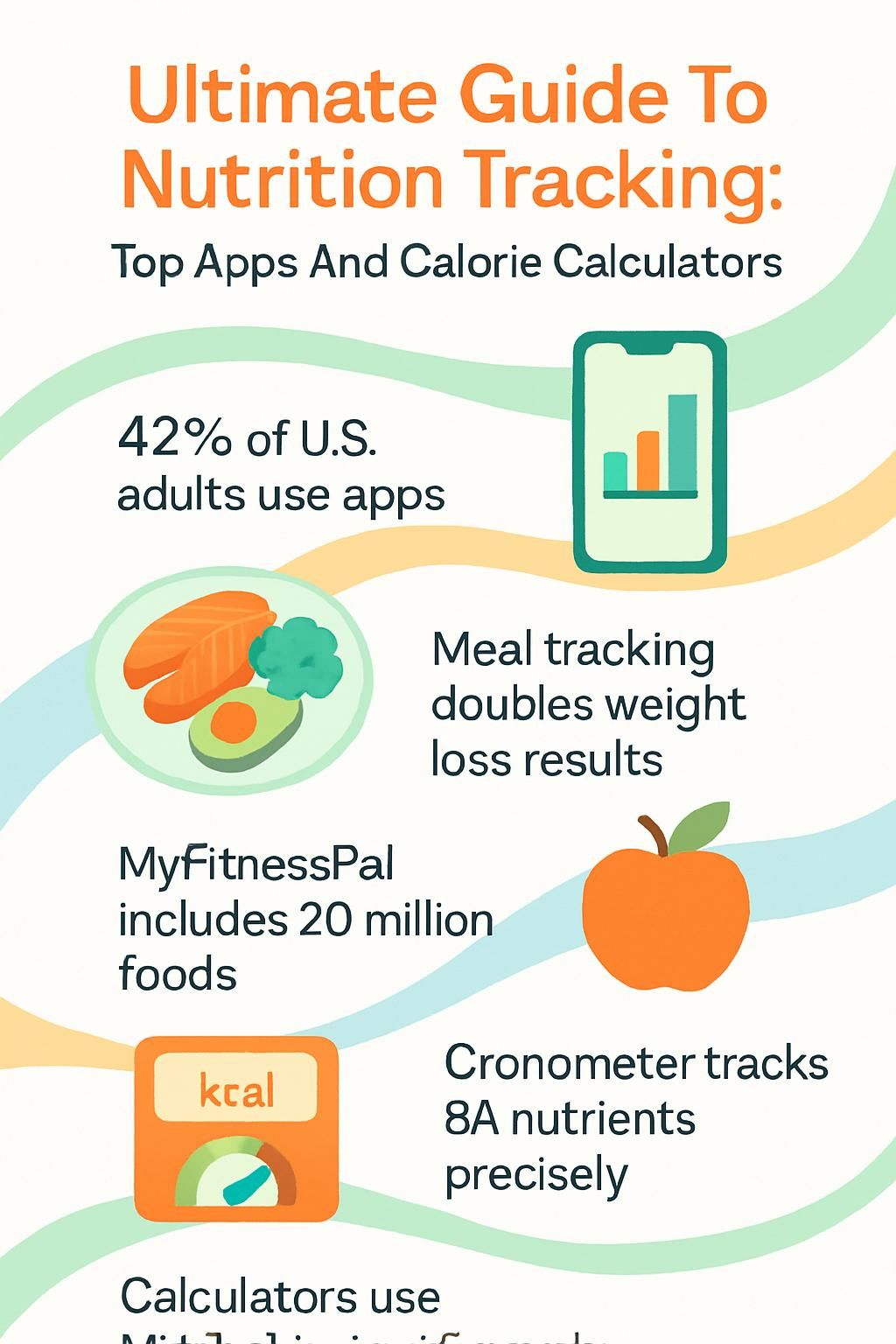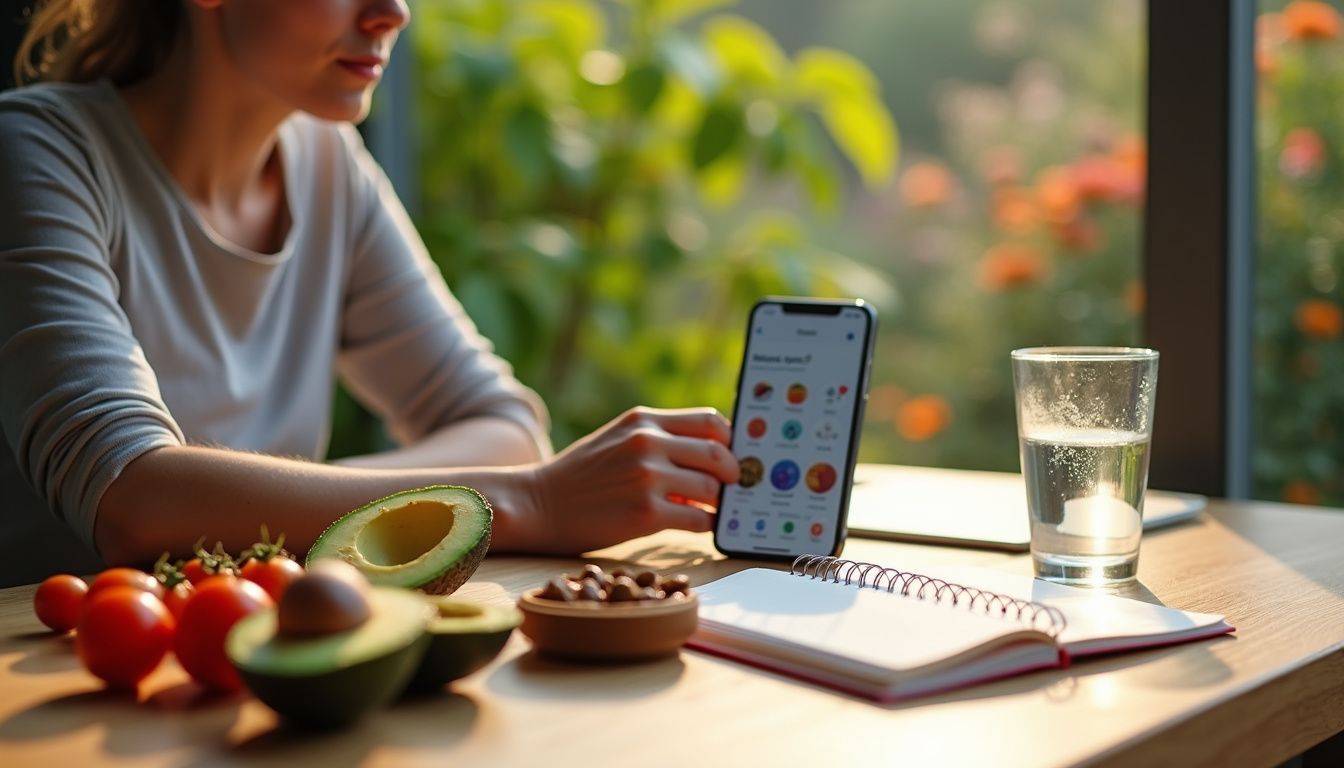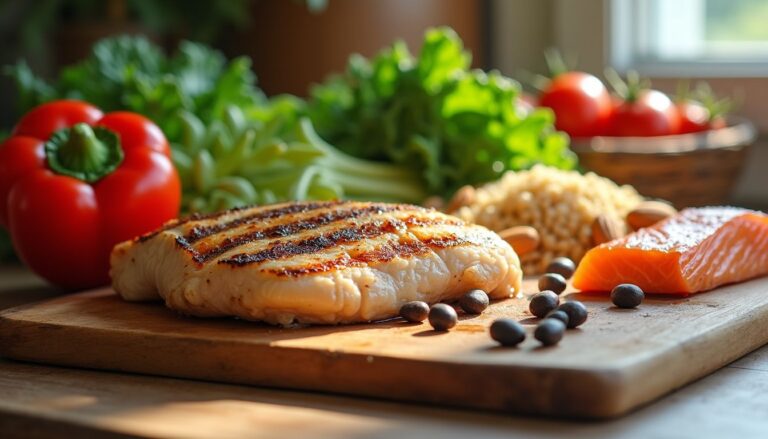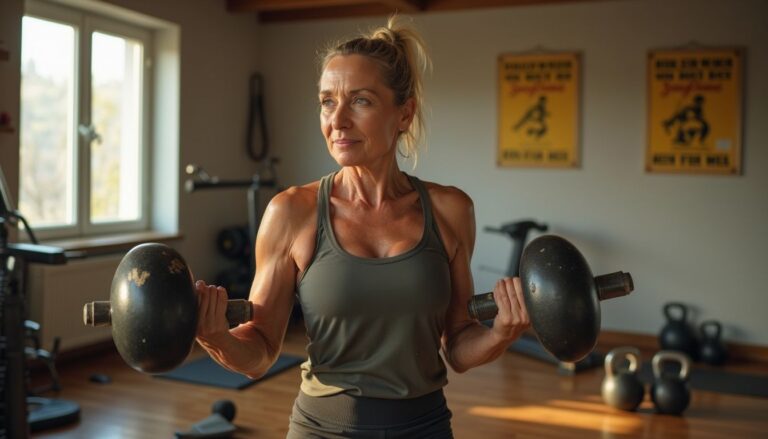Ultimate Guide To Nutrition Tracking: Top Apps And Calorie Calculators
Our Nutrition Assistant AI Suite will transform your body. You will lose fat, get toned, and build muscle. Gain confidence and optimal health.
Keeping a clear food log can be hard, especially if you are busy. Many people use a nutrition tracking app or a calorie calculator to simplify the process. In the United States, about 42 percent of adults report using at least one tool to manage eating habits and health.
This guide highlights the best options to count calories, track macros, and monitor vitamins from your phone. You will see how nutrition tracking, even a few minutes a day, can move you closer to your goals. Small steps add up.
Read on to compare top tools and choose a method that fits your routine.
Key Takeaways
- About 42 percent of U.S. adults use nutrition tracking tools like MyFitnessPal or Cronometer to guide food choices and health goals.
- Food diaries are linked to stronger weight loss. Research in the American Journal of Preventive Medicine shows trackers can lose about twice as much as non-trackers.
- MyFitnessPal lists more than 20 million foods and offers barcode scanning, meal-level analysis, and personalized macro targets.
- Cronometer focuses on accuracy and tracks up to 84 vitamins and minerals. It can sync with devices like Fitbit for deeper insights.
- Most calorie calculators estimate your needs from age, sex, height, weight, and activity level using formulas like the Mifflin St. Jeor equation.

Why Should You Track Your Nutrition?

Tracking what you eat and drink puts real numbers behind your choices. A nutrition app gives quick access to calories, macros, and micronutrient details. Clear data helps you make smart adjustments without guessing.
What are the benefits of tracking your diet?
Research shows that keeping a food diary can double weight loss for many people. A steady routine, such as daily logging in an app, often leads to 1–2 pounds of loss per week. You will see patterns in calories, carbs, protein, fat, and micronutrients that shape better decisions.
You cannot change what you do not measure.
Large food databases and barcode scanning make entries fast and accurate. You also learn serving sizes and typical daily calories. These insights support meal planning and special diets like keto or vegan. Over time, better tracking can help you manage blood sugar and cholesterol.
What are macronutrients and micronutrients?
Macronutrients are nutrients you need in larger amounts. They include carbohydrates, protein, and fat. Carbs from foods like rice, bread, and vegetables fuel daily activity. Protein supports muscle repair and can help you feel full longer. Healthy fats from foods like nuts and avocado aid brain function and hormone balance.
Micronutrients are vitamins and minerals. Your body needs them in small amounts, yet they support many functions. Cronometer can track 84 micronutrients found in foods, such as iron for blood health, calcium for bones, vitamin D for energy regulation, vitamin C for immune support, potassium for blood pressure, and magnesium for muscle and nerve function.
Tracking both macros and micronutrients helps you spot gaps early. Apps like MyFitnessPal monitor calories and macros, plus some key vitamins and minerals. You can also sync data with devices like a Fitbit or Apple Watch for a fuller health picture.
How does tracking support long-term health goals?
Tracking builds awareness and accountability. Many users report steady results after logging meals and staying within targets. For example, one user named Larry S. reported losing 108 pounds through consistent logging and calorie control.
Some apps let you log more than food. You can track symptoms, blood sugar, and other measures that matter for conditions like diabetes. Consistent tracking encourages strong habits, which often leads to better energy, improved body composition, and a more enjoyable routine.
Essential Features in Nutrition Tracking Apps
Good apps make it easy to count calories and review a nutrition facts label. The best ones support different diets and give clear feedback on choices.
Comprehensive food databases
MyFitnessPal and MyFoodDiary host some of the largest food databases available. MyFitnessPal lists more than 20 million foods across packaged items, fresh produce, and restaurants. A trained team curates entries to reduce errors and duplicates, which improves accuracy.
Barcode scanning speeds logging for millions of products. Many apps also include chain restaurant menus and common dishes. If you cook at home, you can enter ingredients and save custom recipes.
An app with a wide food list makes tracking as simple as scanning lunch.
These databases save time and help you meet goals, whether you want weight loss, weight gain, or to reach daily nutrient targets. Many tools align with standard equations like BMR for guidance.
Barcode scanning for quick logging
Barcode scanning lets you point your camera at a package and log its data in seconds. MyFitnessPal and Cronometer both offer this tool. It reduces typing and helps keep your diary complete.
Cronometer reports coverage for most common store items, which helps with everyday logging. Free versions often include simple scanning, while premium tiers may add advanced options. Scanning improves accuracy for calories, macros, and micronutrients. It is especially helpful when you cook with several packaged ingredients.
Integration with fitness trackers and health devices
Pairing your nutrition app with devices brings your data together in one place. MyFitnessPal connects with Apple Health, Fitbit, Garmin, Strava, Samsung Health, and Google Fit. Steps, workouts, and calories burned can appear right in your app.
Cronometer connects with devices that capture biometrics like blood sugar or heart rate. This gives insight into how activity affects your calorie needs, BMI, hydration, and even fasting routines. When I synced my Fitbit with MyFoodDiary, I better understood my true calorie needs by comparing meals with workouts.
Support for various dietary preferences (e.g., keto, vegan)
After syncing devices, you may focus on a specific diet like keto, vegan, paleo, or gluten-free. MyFitnessPal and Cronometer let you set diet preferences and adjust targets. Cronometer’s target wizard helps set custom macro ratios for different approaches.
If you need to monitor key minerals, such as iron for vegans or sodium for heart health, you can track them closely. In my own switch from vegetarian to low carb, flexible settings in both apps saved time and kept me on track. Premium plans usually add more filters and report options.
Insights on macronutrients, calories, and micronutrients
Top apps show calories, macros, and micronutrients in a simple format. MyFitnessPal provides meal and daily breakdowns for calories, protein, carbs, fat, and many vitamins and minerals. Cronometer uses lab-analyzed data to improve precision.
MyFoodDiary reports 21 nutrients daily, which helps you see trends at a glance. Reviewing my totals once showed low calcium despite a balanced menu. That insight led me to include yogurt and leafy greens more often.
Best Nutrition Tracking Apps in 2023
Several popular apps can strengthen your nutrition tracking. Many include fasting timers and water tracking to match your needs.
MyFitnessPal
MyFitnessPal has a large community and strong feature set. You can upgrade to unlock advanced tools like an intermittent fasting tracker and deeper analytics. Reputable outlets like Women’s Health, USA Today, and Good Housekeeping have highlighted the app’s strengths.
Its barcode scanner makes logging quick. Daily reports help you spot habits, both good and bad. Next, consider Cronometer, a strong pick for precise micronutrient tracking.
What are the key features of MyFitnessPal?
- Access a massive food database with more than 20 million entries, including many restaurant items.
- Use barcode scanning or voice logging to add foods fast. The scanner is especially useful for busy days.
- Track calories, macros, vitamins, minerals, water, weight, and exercise in one place.
- Search foods from the home screen to speed daily entries.
- Sync with over 35 apps and devices, including Fitbit and Apple Health, for accurate calorie math.
- View food journals and breakdowns by meal, day, or week to spot trends and adjust.
- Set personal goals using BMR and total daily energy needs from entries like age, height, weight, sex, and activity level.
- Try a one-month premium trial. The basic plan remains available if you choose not to subscribe.
These tools give you flexibility. You can match the app to your diet and schedule.
What are the pros and cons of MyFitnessPal?
Using MyFitnessPal has clear upsides and a few tradeoffs. Review the list below before you commit.
| Pros | Cons |
|---|---|
|
|
Weigh these points, then compare them with Cronometer’s strengths below.
Cronometer
Cronometer focuses on accurate nutrient data. It tracks both macros and a wide range of vitamins and minerals, which is helpful if you want detailed coverage. Many nutrition professionals use it for that reason.
You can choose a personal plan or Cronometer Pro for dietitians and trainers. Barcode scanning and clear nutrient reports help you see if your daily intake matches your goals.
What are the key features of Cronometer?
- Lab-analyzed food database for precise nutrient values across common and specialty foods.
- Barcode scanner that recognizes most popular items, which reduces typing.
- Device syncing to track biometrics like blood sugar and more.
- Nutrient target wizard to set goals for weight management and accountability.
- Recipe imports for exact macro and micronutrient breakdowns of homemade meals.
- Automatic energy adjustments based on weight entries over time.
- Feature-rich free version with optional premium upgrades for deeper insights.
What are the pros and cons of Cronometer?
Consider the following highlights and limitations before you choose Cronometer.
| Pros | Cons |
|---|---|
|
|
Lose It!
Lose It! focuses on speed and simplicity. The app makes barcode scanning and meal logging quick, which helps with daily consistency. You can use the free version for basic tracking or upgrade for advanced nutrient analysis.
Lose It! also supports personal goals and offers a community space for support. I found the quick scanner useful while shopping, since I could check items before adding them to my cart.
What are the key features of Lose It!?
- Free trial, with premium at about $9 per month for advanced tools.
- Fast barcode scanning for accurate logging of packaged foods.
- Large database with grocery, restaurant, and homemade meal entries.
- Calorie goals based on BMR and total daily energy needs.
- Many users report significant weight loss and improved health markers.
- Food journal praised by CNET for supporting success.
- Syncs with popular trackers so activity and nutrition are in one place.
- Tracks macros, key micronutrients, and progress charts.
- Flexible for diets like vegan or keto within your targets.
- Positive reviews highlight ease of use and steady results.
What are the pros and cons of Lose It!?
Here is a quick look at where Lose It! excels and where it falls short.
| Pros | Cons |
|---|---|
|
|
In my experience, the scanner was fast and reliable. Homemade recipes may take extra effort, but the database covers most grocery items.
MyFoodDiary
MyFoodDiary includes a large database of more than 20 million foods and a fast barcode scanner. It also calculates nutrition for recipes, which helps if you cook at home. The app tracks 21 nutrients and syncs smoothly with Fitbit devices.
All premium features are included for about $9 per month after a free trial. CNET has recognized it as a strong choice for serious tracking.
What are the key features of MyFoodDiary?
- Eight food entry tools so you can log meals from home or restaurants.
- Detailed nutrition analysis for calories, macros, and micronutrients in every entry.
- Exercise log to see how workouts affect daily calorie balance.
- Body log that tracks weight and measurements over time.
- Short video tutorials to help you start fast.
- Instant feedback after each entry to guide choices.
- Motivation tools like streaks and badges to build consistency.
- Support for common dietary preferences like keto, vegan, and gluten-free.
- Integration with fitness trackers for an all-in-one view.
- Clear weekly reports that highlight trends you can act on.
I used MyFoodDiary while returning to sports after an injury. The weekly reports showed which foods supported energy on heavy training days.
What are the pros and cons of MyFoodDiary?
Users praise MyFoodDiary for simple tools and helpful feedback. The barcode scanner saves time, and the food database is easy to search. Some users share strong results, like dropping clothes sizes with steady logging. Many people average 1 to 2 pounds of weight loss per week when they track consistently.
On the downside, the monthly fee is about $9 after the trial. Some power users may want deeper nutrient detail found in Cronometer or MyFitnessPal premium. Goal setting is clear but less advanced for complex diets.
As you compare tools, match the features to your priorities, such as detail level, ease of use, and cost.
MyPlate by USDA
MyPlate by USDA is a helpful guide for balanced eating. There is a free trial, and ongoing access is about $9 per month. Some users report major weight loss and better blood pressure and cholesterol while following MyPlate’s structure.
Food journals like MyPlate are linked with better results, often double the weight loss seen without a diary. Its simple, visual approach makes daily choices easier by focusing on food groups and portions.
What are the key features of MyPlate?
- An illustrated plate shows five food groups, fruits, vegetables, grains, protein, and dairy.
- Half your plate filled with fruits and vegetables supports health and weight management.
- Whole grains replace refined grains to boost fiber intake.
- Portion visuals help you manage calories at each meal.
- Use the app or website to track food choices and connect to popular trackers.
- Encourages variety within each group to improve micronutrient coverage.
- Simple graphics teach the basics of balanced eating at a glance.
- Tips favor lean proteins and low-fat dairy to improve nutrient quality.
- Guidance comes from the USDA Dietary Guidelines for Americans.
What are the pros and cons of MyPlate?
MyPlate’s clear visuals make balanced meals easier to plan. It works for most ages and many preferences. The approach is strong for teaching portion control and food variety.
On the other hand, it may not meet complex needs like food allergies or specific medical diets. It offers general guidance rather than personalized plans. Apps that use MyPlate principles can still deliver strong results, but advanced tracking may require a different tool.
How Do You Choose the Right Calorie Calculator or App?
The right tool fits your goals, your schedule, and your level of detail. Use the steps below to estimate needs and adjust with real data.
How can you determine your daily calorie needs?
- Enter age, height, weight, and sex into a calorie calculator or nutrition app.
- Calculate your Basal Metabolic Rate, or BMR, often with the Mifflin St. Jeor equation.
- Select an activity level, from sedentary to very active, to estimate your total daily energy needs.
- Set a reasonable deficit or surplus, based on whether you want to lose or gain weight.
- Compare your target with credible guidance, such as the Dietary Guidelines for Americans.
- Track intake for at least one week and watch weight and energy changes.
- Use barcode scanning and a strong food database to keep entries accurate.
- Review weekly reports and fine-tune your target before plateaus form.
What are BMR and TDEE, and why do they matter?
BMR is the calories your body uses at rest to run basic functions like breathing and repair. TDEE is your BMR plus the calories you burn through daily activity and digestion. If your BMR is 1,500 calories and you train, your TDEE could be 2,000 or more.
Knowing both helps you set the right calorie goal in your app. Many tools estimate BMR and TDEE using your data, which supports safe weight gain or loss while protecting nutrient intake.
How do you set realistic health goals?
- Set one clear goal, such as losing 10 pounds in three months.
- Use a reliable calorie counter or app to monitor intake and progress.
- Aim for a safe rate of 1–2 pounds per week, as advised by the CDC.
- Break big goals into small steps, such as adding a serving of vegetables at dinner for two weeks.
- Track macros and key micronutrients for balanced nutrition.
- Match goals to your lifestyle and any medical advice you receive.
- Check progress weekly and adjust targets if motivation slips.
- Celebrate small wins, like hitting a fiber goal or logging every day.
Advanced Nutrition Tracking App Features
Modern tools can personalize your plan with timing, hydration, recipes, and detailed reports.
What are intermittent fasting trackers?
Fasting trackers log your eating and fasting windows, then display charts so you see progress. Premium MyFitnessPal users can track fasting alongside calories and nutrients in one place. Timely reminders help you avoid breaking a fast early or missing meals later.
How does water intake monitoring work?
Water tracking lets you record glasses or ounces through the day. Apps show your total and how close you are to your goal. You can set custom targets based on weight, activity, or climate.
I set two-hour reminders after noticing afternoon headaches. Tracking showed that hydration, not snacks, fixed the problem.
How can meal planning and recipe suggestions help?
Recipe tools estimate accurate nutrition for homemade meals. Cronometer allows recipe imports and scanning for precise analysis. MyFoodDiary calculates nutrition for recipes you build, which helps you see calories and macros before you eat.
Suggestions reduce food ruts and support variety. You get options that match your diet, like keto or vegan, while keeping nutrients balanced.
What are customizable reports and progress tracking?
Custom reports let you pick the data you want to see, such as calories, protein, or fiber by day or week. MyFitnessPal provides detailed breakdowns that match your logging habits.
Progress tracking covers weight, measurements, and patterns. In MyFoodDiary, I liked the weekly graphs because they made small changes easy to spot. Reviewing reports helps you adjust your plan with confidence.
What Are Common Challenges in Nutrition Tracking?
Tracking takes practice, and some parts are tricky. The tips below can help you handle common roadblocks with less stress.
Why is logging restaurant or homemade meals difficult?
Restaurants do not always share full nutrition facts, so you must estimate ingredients and portions. Homemade meals are also tough because many people do not weigh every ingredient or measure servings. Even with recipe tools, accuracy depends on the details you enter.
Apps try to help with restaurant menus and recipe features. Still, expect some margin of error when you cannot verify exact ingredients.
How accurate are food databases?
Accuracy varies by source and update frequency. Cronometer leans on lab-analyzed data for many foods, which improves precision. MyFitnessPal curates its database to reduce duplicates and wrong entries.
Expect small differences across apps or brands as recipes and portions change. I once compared chili entries across apps. Cronometer showed more complete micronutrients, but I still adjusted for my exact ingredients. Treat databases as guides, not perfect records.
How can you stay consistent with tracking?
Set daily reminders to log right after meals. Consistency improves accuracy and builds the habit. Choose a regular time to enter data, such as evenings, if that works better for you.
Log snacks and drinks, since those calories add up. Use barcode scanning to speed things up. Sync your app with your tracker so exercise data populates automatically. Reliable records reveal trends that motivate you to keep going.
What Are Tips for Effective Nutrition Tracking?
Simple routines, a bit of automation, and weekly reviews keep you on track and reduce stress.
How do you start small and build a habit?
Begin with one meal, like breakfast, for a full week. Keep it simple. Track calories first, then add macros and micronutrients later.
Set reminders and use barcode scanning for packaged items. Once breakfast logging feels automatic, add lunch or dinner. Small wins build momentum.
How can automation features like barcode scanning help?
Barcode scanning saves time and reduces mistakes. Point your phone at the package, and the app fills in calories and nutrition. Cronometer covers most common foods. MyFitnessPal scans nearly all store items.
This tool helps you stick to daily goals without long searches. It is especially useful for snacks and new products.
Why should you review your progress weekly?
Weekly reviews reveal patterns you might miss day to day. MyFoodDiary’s reports, for example, show shifts in calories or macros over time. Seeing progress, even small changes, keeps you motivated.
If you notice low vegetable intake or high added sugar on certain days, set one focus for the next week. Regular self-monitoring is linked to better outcomes in weight loss programs.1
1: Burke, L.E., et al., “Self-Monitoring in Weight Loss: A Systematic Review of the Literature.” Journal of the American Dietetic Association, vol 111(1), 2011, pp. 92–102.
How can you be flexible and avoid perfectionism?
Allow for estimates and imperfect entries. Focus on patterns over time, not single meals. If a restaurant dish is hard to log, pick the closest match and note the portion.
Set practical goals. If social events make tracking tricky, log the basics instead of skipping the day. Consistency beats perfection. Guidance from Harvard T.H. Chan School of Public Health supports flexible, balanced eating for long-term success.
Conclusion
Choosing a nutrition tracking app, such as MyFitnessPal, Cronometer, or Lose It!, can make healthy eating simpler. A calorie counter and a reliable calorie calculator help you set targets, then daily logs keep you honest. Barcode scanning, strong food databases, and clear reports save time and improve accuracy.
Start small and build the habit. Review progress every week and adjust as needed. If you have a medical condition, talk with a qualified healthcare professional or a registered dietitian for personalized advice. With steady tracking, you can make informed choices and move toward your health goals with confidence.
FAQs
1. What is nutrition tracking and how do top apps help with it?
Nutrition tracking means recording what you eat to monitor nutrients and calories. Leading food loggers use large databases, barcode scanners, and meal planners to make this process simple. Many of these tools also sync with fitness trackers for a complete health overview.
2. How accurate are calorie calculators in popular nutrition apps?
Calorie calculators in trusted diet monitoring platforms rely on scientific formulas like the Mifflin-St Jeor equation or Harris-Benedict formula for estimating energy needs. Studies show that while most provide close estimates, accuracy depends on honest input of age, weight, height, activity level, and food choices (Schoeller et al., 2015).
3. Can using a nutrition tracker improve eating habits?
Research supports that consistent use of digital intake journals can lead to better awareness of portion sizes and nutrient balance (Carter et al., 2013). In my experience logging meals daily helped me spot patterns such as high sugar snacks after lunch which I then replaced with fruit.
4. Which features should I look for when choosing a calorie counting app?
Key features include an extensive verified food database; easy entry methods like photo recognition; personalized goal setting; integration with exercise monitors; clear data summaries; privacy controls; and evidence-based recommendations from registered dietitians.
Summary: Nutrition tracking through advanced applications offers reliable ways to monitor dietary intake using science-backed algorithms and user-friendly interfaces. Selecting the right tool involves checking its accuracy, feature set, ease of use, privacy options, and support from qualified professionals.






